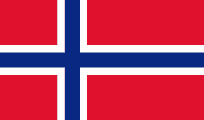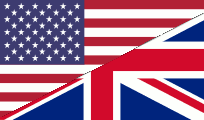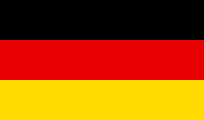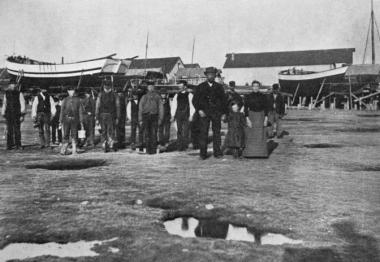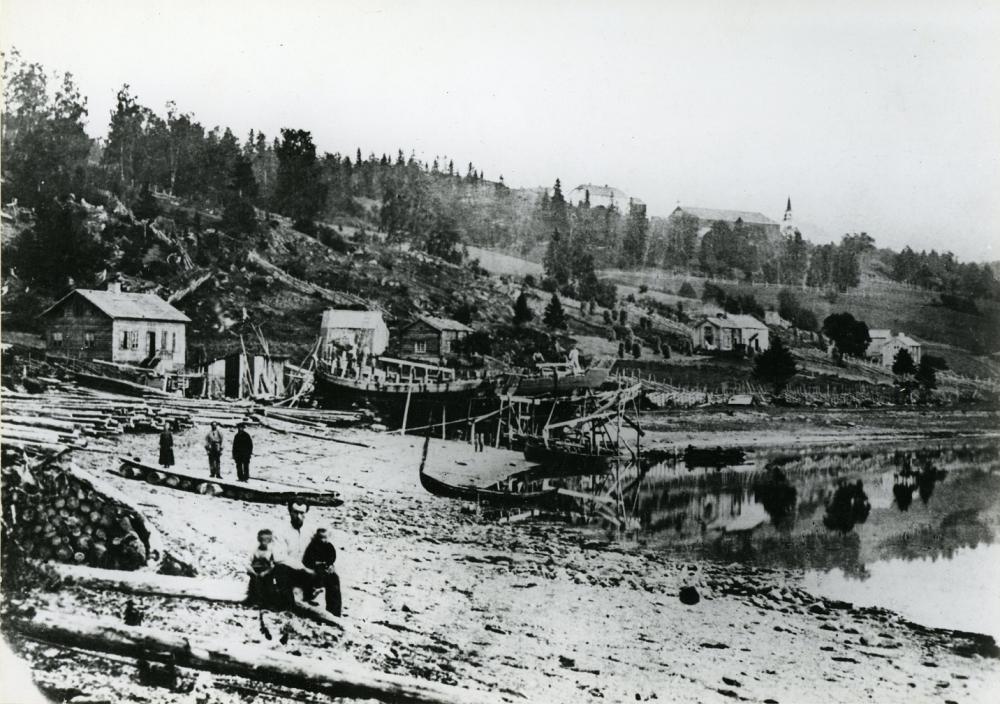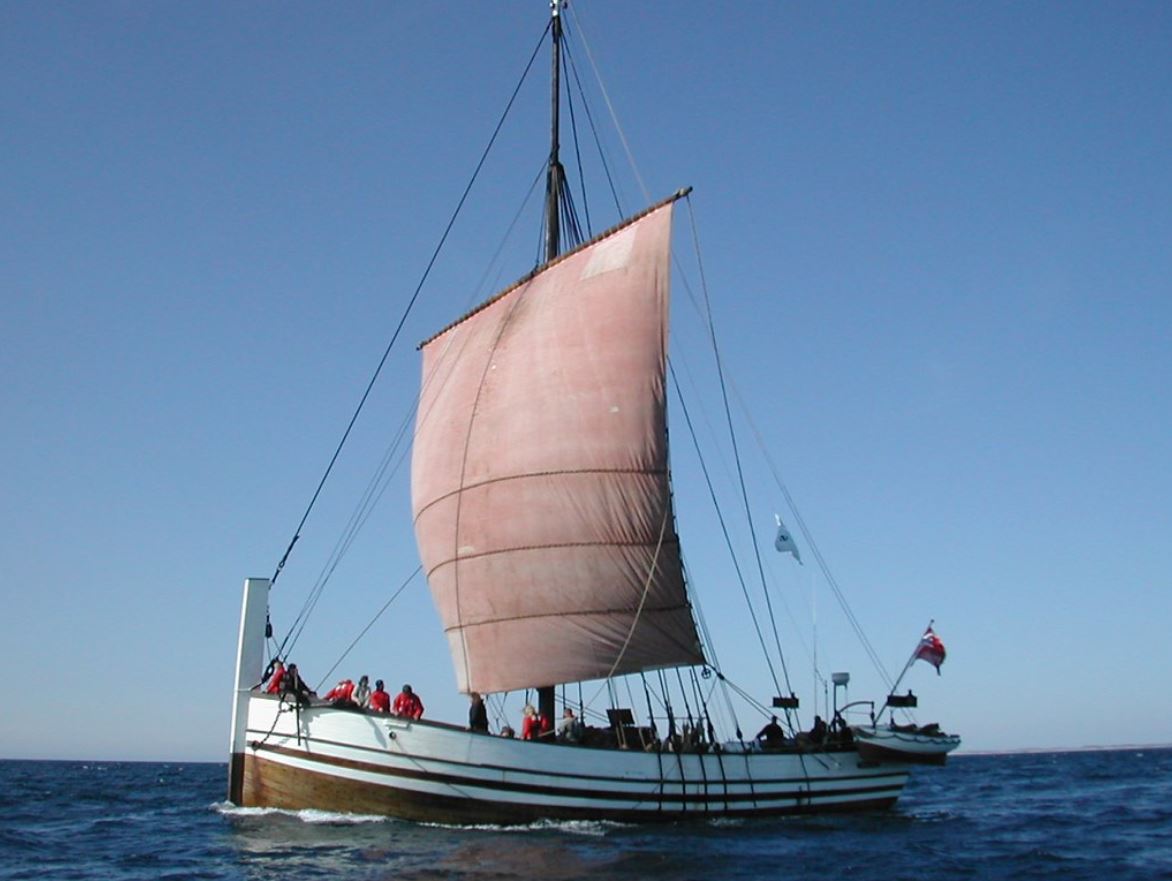
JEKT USED FOR SHIPPING,
AND THE INFLUENCE IT HAD
It was built more than 1300 windjammerboats
known as a "Jekt" in the area of Steinkjer.
When a Jekt was launched, it was an absolute necessity to play music from a Steinkjerpositive, "if not, then things at sea could go wrong". Tradition was to hold three parties before a jekt could have water under the keel. Positives were often used for music at these parties, but the instrument was also a part of keeping the a good atmosphere on the maiden voyage. In this manner the Steinkjerpositives were distributed up along the Norwegian coast. They would also be used as music for dancing on the docks when the ship came back after a trip.
Shipping.
One of the causes for the relative large scale production of barrel organs in Steinkjer is due to another Norwegian tradition, boat building, and in particular the building of the local windjammer boat called a "Jekt". The fjord of Trondheim is well known for it large scale production of Jekts, a tradition founded on the large need for transport of goods up and down along the convoluted Norwegian coastline.
Speakers of English should not be misled by the word jekt which seems so similar to yacht. A jekt not a yacht, but instead is similar in purpose to other small coastal commerce vessels such as the fore-and-aft rigged windjammer schooners famously used on the coast of Maine.
Shipyard owner Ovesen, boat builder in Steinkjer. Photo: Henriksen. © Egge historielag 2011/Lars Lilleby Macedo.The music from a Steinkjerpositive was entertainment during the trip, and the music was played on the docks when the boats came back to port. The music for dances contributed to a small income in addition to the transport.
The instruments for this reason traveled automatically up and down along the Norwegian coastline, and the positives could end up quite far away from Steinkjer.
The Jekt was the most popular means of transport between the villages and towns in the 1600, 1700 and 1800's. The local Jekt from the Trondheimsfjord called Innherredsjekt had a square sail as the old Viking ships. This made it stand apart from the fore-and-aft rigged Jekts which had both staysails, mizzen sails and gaff topsail.
The Jekt's sail was the most important part of the vessels character and look. The square sail was up to 12 meters wide and 15 meters high. in the beginning of the 1800's the most common size were around 400-500 barrels, which ment between 20 and 30 Commercial Cargos, approximately between 41 and 62 register ton. But there were also large Jekts up to 100 Commercial Cargos and 30 meters keel length. Towards the end of the era of the large Jekts around 1890, the largest wessels could carry between 800 and 1000 barrels. These vessels were very sought after in the freight marked between Bergen and Vardø.
The Jekts were not made for fast sailing, and it was hard to beat with a Jekt. Beating is sailing to windward by taking a zig-zag course. However if a Jekt got good wind, the speed could be high, and it was possible to race them. This was due to the hulls bottom, which helped a Jekt to "plane" with tailwind. Up to 16 knots was possible, and the trip between Bergen and Vadsø, sailing over a thousand miles, could be done in a week, or Agdenes to Lofoten in 2-3 days.
The foundation for shipping with Jekts was the rather excellent condition for growth which existed in Innherred. The good production from the primary sector, allowed for sale of products from both farmers and forestry. The Jekt from Steinkjer could ship grain and bread, meat and diary from the agriculture production to buyers in Trondheim and to people in the north of Norway. People having their income from the seasonal fishery from the north was also an important market.
A part of the Jekt shipping from Steinkjer have been described as a triangular trade. This was visible especially in the time after 1860, when the herring fishing along the coastline really became huge. The Jekt was often used as a cache for herring and fish which were salted on board, while the fishing activity proceded. But when Jekt skippers sailed north in such missions, they loaded the boat with agricultural produce and dairy products to sell.
Furniture, Steinkjerpositives, lumber, even prebuilt houses could be shipped northwards. And on the trip back, the Jekt was usually loaded with fish to be delivered in Møre (for clipfish production), or fish and herring to be delivered in Trondheim or Bergen. The last line in the triangle was consumables to or from Tronheim (and other places) home to Steinkjer. Those goods in turn could be sold in the new shops which had established in the small town. Steinkjer in 1857 became a staple port. It was in that period a rather extensive production of Steinkjerpositives in Steinkjer, which due to the Jekt shipping found buyers nationwide.
Jekt building.
Jekt building in Eggebogen. Photo: Egge historielag.A determined, and sharp sound was to be heard in Steinkjer for the whole of the summer 1879. It was the sound of Jekt building, the sound of hammers hitting the long rivets into their place in the wood. The building of new vessels, and the sound did travel far. This summer two Jekts were built at the same time, almost in the same location where the city hall is located today. Probably it was activity of both building and repair of Jekts around the town as well. Nearby at Nordsileiret, in Eggebogen and in Steinvika. In 1879 did the Jekt trade reaced an apex.
Is it possible to describe Steinkjer as the the town of Jekt shipping? Yes, there is probable cause for such a claim, even if we look nationwide and not only Trøndelag. The Jekts from the north of Norway might be more known, and it is easy to be mislead to believe that the north of Norway was the center for use of such vessels. Surprisingly it can be read in taxation and treasurers' forms: Bodø had 20 large Jekts in 1880, while Steinkjer had 40!
Bodø is mentioned here only to make the point of Steinkjers local history as a center of Jekt shipping. And it was not only the city of Steinkjer which had many Jekts, but also in the villages around the town. Especially on the west side of the fjord the Jekt shipping stood strong. How is it possible to explain the fluorishing maritime environment in the thickest of farmland in Trøndelag? How come the "city of villages" also become the city of the Jekts?
Firstly we can mention the modernization of the society demanding more means of transport, not only in Innherred, but many places in the nation. The liberalization with new businesses and city growth allowed people move much more than before. This led to greater demand for trade, since the people who moved to the cities needed food and other goods which they previously had produced for themselves.
Construction and improvement of the communication in Norway was active in the mid 1880's. But the roads were still steep, winding and demanding to travel. The sea on the other hand, the old traditional transport way, was available and ready to use. As in other seaside parts of Norway, the knowledge about and the use of sea and boats, had been passed on for generations. Here in the district of Steinkjer, the use of large boats and Jekts had a natural part in a day to day life. It was common knowledge where the agricultural sector otherwise dominated. The need of transport for goods in large volume and weight were present, and the Jekt was in use a long time ahead of the liberalisation of the businesses.
The use of large boats (Jekts) were also here in Innherred incorporated as a natural part of the work in a businesslife, where the primary sector did dominate. It might have been similar in many ways all along Norway, but there were a couple of other factors which were especially good for Innherred, and which contribute to explaining how the innermost part of the fjords of Trondheim could achieve such a position in the shipbuilding and sailing.
The material for building large boats was very accessible here, and there is a lot of forest in Trøndelag, perhaps more than in other parts of Norway. Also, because in Innherred the forest was close to the seaside, it was easy to transport the timber to the sea using the multitude of large rivers carrying water from the highlands to where the building was being done.
Pauline the Innherredsjekt
"Pauline" is a veteran ship, with port in Kjerknesvågen dock in Inderøy, Trøndelag. The owners are the foundation Stiftelsen Egge Museum. Pauline is one of very few remaining Jekts from the 1800's. Pauline was transferred from its earlier port in Steinkjer to the current in Kjerknesvågen in 2008.
Pauline was built in 1860, as a clinker built vessel, originally named "Letnesjekta" after the farm where the owners lived, in Letnes, Inderøy. Later the vessel got the name "Pauline" after the shipowners wife. In 1897 she was rebuilt by Jekt builder Nils Ovesen in Steinkjer as a carvel built vessel. The boat worked in shipping between Trondheim - Arkangelsk and Bergen with timber, merchandise and fish.
In conjunction with a wrecking incident in 1914, the squaresail rig was replaced with a galeas rig. At the same time a small petroleum engine was installed.
In 1915, Pauline was bought by Julius Sand in Eggebogen and was renamed to "Nævra". The vessel from thereon did shipping in the Trondheimsfjord and Fosen with among other things, timber, chalk and clipfish. Around 1950 she was sold to Albert Garnvik in Trondheim.
In 1952 she was rebuilt and substantially modified on the island of Hitra before she was set to shipping woodchips between Namsos, Innherred and Ranheim papermills. In 1972 "Nævra" was sold, and did ordinary coastal traffic until 1978 when she was set ashore in Harstad.
In 1979, "Nævra" was bought by the Steinkjer Museun. Restoration back to squaresail rigging was started in 1980 and completed in 1986. The ship is today owned by Stiftelsen Egge Museum and in coorporation with Nord-Trøndelag fylkeskommune she was restored back to how she looked after the rebuild in 1897.
• Olav L`Orange Jekts and shipping from Innherred. Nord-Trøndelag Historielag 1989.
• Kjell Saxvik: Trade and traders in old Steinkjer, 1970.
• Emblem, Libæk, Stenersen: Norge 1, Cappelen, 1997.
• Trøndelag history, Tapir akademisk forlag, 2005
• Steinkjer knowledgeportal, http://v1.steinkjerkunnskapsportal.no
• English language spelling correction and language improvement - Peter Neilson, North Carolina.
